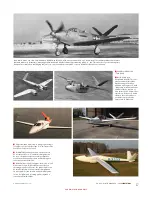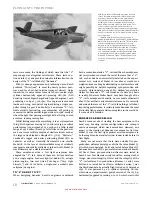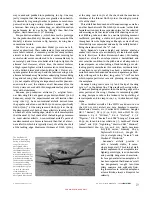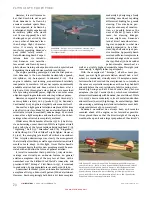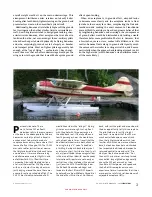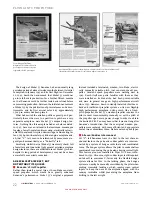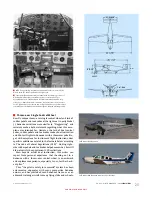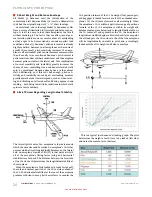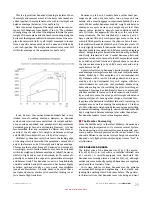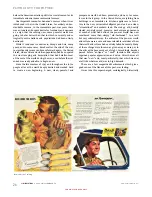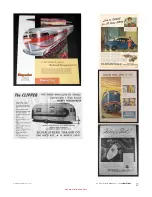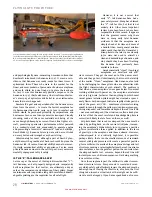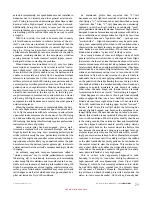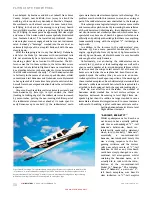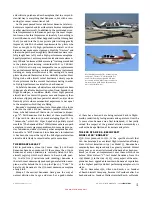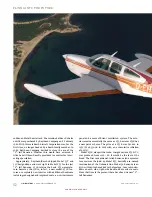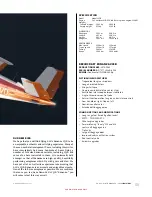
18
A2A
SIMULATIONS :::
ACCU-SIM V35B BONANZA
FLYING INTO THE FUTURE
FOR SIMULATION USE ONLY
tests were made, the findings of which were that the “V”
empennage was altogether satisfactory. These tests con-
tinued into 1945 and provided valuable information for the
design of the “V”- tail Model 35 “Bonanza.”
With its strange appearance and confusing name, Beech
produced “Twin- Quad” to meet the newly re- born post-
war need for short- haul airline transport aircraft. Quite
innovative, its name comes from its four air- cooled, eight
cylinder horizontally opposed Lycoming GSO- 580 (GSO
denoting Geared Supercharged and Opposed engines,) each
producing 400 hp at 3,300 rpm. Two engines are mounted
inside each wing, each pair of engines driving a single pro-
peller through a gear- box. Model 34’s enormous “V”- tail,
while visually fascinating, was somewhat off- putting to
conservative airline purchasing executives in 1948, many of
whom thought that passengers might balk at flying in such
a curious- looking contraption.
Whilst timing may not be everything, it is a very important
thing. With spacious seating for 20 and/or cargo, excellent
performance (top airspeed of 240 mph and a fully- loaded
range of 1,456 miles,) Beech 34 fell victim to the post- war
era’s enormous military surplus of similar aircraft such as
the larger and ubiquitous Douglas DC- 3/C- 47 “Skytrain,”
Lockheed’s rugged and better performing Model 18/C- 60
Lodestar, as well as, ironically, Beechcraft’s own smaller
Model 18. In the face of this formidable array of relatively
inexpensive and readily available surplus aircraft, Model 34
was ultimately not a viable alternative.
These aeroplanes aside, a few light aeroplanes have
adopted the “V”- tail. Some of these are: Eclipse Aviation
400, a single engine, four- seat light jet; Robin ATL, a single
piston- engine, two- seat Avion Très Léger (“Very Light
Aircraft,”) and H- 101 Salto, a single- seat aerobatic pure
sailplane (no engine).
TO “V” OR NOT TO “V?”
When designing Bonanza, Beech’s engineers considered
both a conventional and a “V”- tail until Beech aerodynami-
cist Jerry Gordon convinced the rest of the team that a “V”-
tail, such as had been successfully installed on the experi-
mental A- 19 variant of Model 18 (see above,) would save
weight and reduce drag by eliminating an entire surface and
might possibly be helpful regarding spin prevention and
recovery. Unfortunately, none of Mr. Gordon’s speculative
claims for Bonanza’s “V”- tail turned out to have any basis
in reality. Whatever Walter Beech may have thought of the
“V”- tail’s aerodynamic benefits, he was most enthusiastic
about it for aesthetic and commercial reasons. He correctly
understood that even if the “V”- tail did nothing at all about
improving performance, it certainly made Bonanza the most
distinctive light general aviation aeroplane in the world. So
it was and so it remains.
BONANZA’S GRAND DESIGN
Beech’s team set about creating the new aeroplane in the
usual way, drawing various configurations and concepts
until one emerged which was deemed best. However, one
aspect in the creation of Bonanza was unique for its time:
Model 35 was the first light general aviation aeroplane to
be thoroughly and extensively wind- tunnel tested before its
first flight.
Many are not aware that there were actually five pre-
production airframe prototypes of what became Model 35,
all which were designed, built and tested before Model 35
Bonanza became Beech’s general aviation standard bearer.
All five of these pre- production airframes were tested in
Beech’s ten- foot diameter wind tunnel for, amongst other
things, structural integrity, flutter and the integrity of the
“V”- tail surfaces. Pre- production airframes 1, 2 and 5 were
built and so tested but not flown. Airframe version 3 was
the first Bonanza to be actually flight tested on 22 December
1945. It was powered by a 4- cylinder Lycoming GO- 290
which was an experimental, geared version of the 125 hp,
horizontally opposed Lycoming 0- 290 CP, which was in this
1947 Beech Model 35 Bonanza prototype version 4
of the 5 Bonanza airframes which Beech built and
tested. Version 4 was submitted to obtain Model
35’s certificate and was extensively flight tested,
including a dive test to 286 mph in the manner in
which military aircraft of that era were tested. This
very aeroplane is pictured in numerous Beech
promotional advertisements and, as usual regarding
such promotions, Beech populated it with the smallest
people it could find in order to make its cabin appear
more capacious.
In March 1949, Bonanza prototype version 4,
named “Waikiki Beech” and piloted by Captain William
Odom, flew from Honolulu, Hawaii to Teterboro, New
Jersey, establishing the existing non- stop long-
distance record for light general aviation aircraft of
4,957 miles. Between 7 October 1951 and 27 January
1952, Congressman Peter F. Mack, Jr. completed a
solo, easterly around the world flight from and back
to Springfield, Illinois in this same aeroplane, which
he named “Friendship Flame,” flying 33,789 miles in
223 hours (113 days) and stopping at 45 cities in 35
countries.
Summary of Contents for BONANZA ACCU-SIM V35B
Page 1: ...A2ASIMULATIONS BONANZA ACCU SIM V35B BONANZA ...
Page 3: ...A2ASIMULATIONS BONANZA ACCU SIM V35B BONANZA ...
Page 5: ...www a2asimulations com ACCU SIM V35B BONANZA A2ASIMULATIONS 5 FOR SIMULATION USE ONLY ...
Page 27: ...www a2asimulations com ACCU SIM V35B BONANZA A2ASIMULATIONS 27 FOR SIMULATION USE ONLY ...
Page 58: ......
Page 68: ...68 A2ASIMULATIONS ACCU SIM V35B BONANZA www a2asimulations com FOR SIMULATION USE ONLY ...
Page 112: ......














